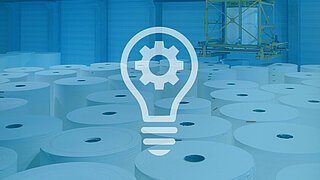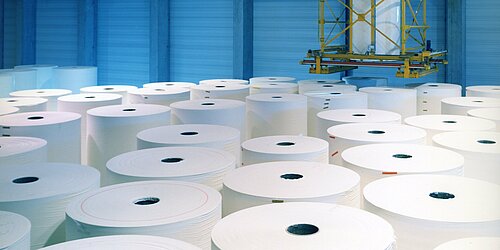Paper production causes high levels of greenhouse gas emissions
Around 3,000 different kinds of paper, paperboard and cardboard made from wood and pulp are used on an everyday basis. As packaging materials, they are used to protect and safely transport the products that we buy, making them indispensable both in retail and logistics. As a printable medium, paper is found in everyday objects like books and magazines, as well as being extensively used for hygiene products (paper tissues, kitchen towels and toilet paper).
In 2020, around 21.3 million tons of paper, paperboard and cardboard were produced in Germany, making the paper industry an emitter of roughly 14.2 million tons of fossil carbon. This figure accounts for about 7.1 percent of all industrial emissions in the same year. Compared with energy-related emissions, however, process-related carbon emissions are negligible in pulp, wood and paper manufacturing.
Climate-friendly heating technologies
The production of paper requires a large input of heat, which is used for the dewatering and drying of the wood chips that are then boiled in a chemical ‘liquor’. The heat is mostly produced via steam as well as direct combustion (e.g. for hot air). The fossil fuels used release CO2 as they burn. Solution strategies for this process step consist of meeting electricity and steam requirements with renewable energy, while also replacing the natural gas used for combustion-based drying processes. One option here is the partial electrification of the process chain and a transition to hydrogen or purified renewable methane. However, research still needs to be conducted into the combustion-based drying processes and some of the steam production technologies – such as the use of geothermal power – that are not yet widespread.
Climate-friendly solution strategies include the partial electrification of the process chain and the transition to hydrogen or purified renewable methane.
Renewable energy – a limited resource
One particular obstacle blocking the transition to climate-neutral production is a lack of availability in relation to renewable energy sources. There is still a persistent risk of supply bottlenecks as a result of fluctuations in power generation. Even brief interruptions to the electricity supply of less than a second can have disastrous effects in manufacturing. This occurs particularly as a result of the synchronised production chains used in the paper industry. For the efficient use of renewable energy, the electricity market itself needs to be redesigned with the aim of promoting climate-neutral processes. In addition, if a legal framework were to be created for the option of bioenergy with carbon capture and storage (BECCS), then the industry could function as a carbon sink.
Examples from practice

Kabel ZERO
Deep geothermal power plant with climate-neutral paper drying

High-voltage electrode pressure vessel
Carbon-neutral heat production in the paper industry (and others)
